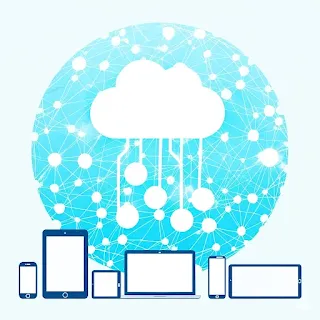What is Cloud Computing and How Does It Work?
In the digital age, the way we store, access, and process data has evolved significantly. One of the most transformative innovations powering this change is cloud computing. Whether you're streaming a movie, accessing emails, or backing up your smartphone photos, you're already using the cloud. But what exactly is cloud computing, and how does it work? In this blog post, we'll dive into a comprehensive explanation of cloud computing, its architecture, benefits, types, and real-world applications.
 |
| Cloud-Computing |
What is Cloud Computing?
Cloud computing is the delivery of computing services—including servers, storage, databases, networking, software, and analytics—over the internet ("the cloud"). This model enables users to access and manage resources without owning or maintaining physical hardware. Instead of running software or storing files on a local device, users leverage remote servers hosted by cloud providers like Amazon Web Services (AWS), Microsoft Azure, or Google Cloud Platform (GCP).
At its core, cloud computing allows businesses and individuals to use IT infrastructure on demand, scaling up or down as needed, and paying only for what they use.
Key Components of Cloud Computing
Understanding cloud computing requires a look at its primary components:
1. Infrastructure as a Service (IaaS)
IaaS offers virtualized computing resources via the internet. Examples include virtual machines, storage, and networking. Users can rent these resources and install their operating systems and software.
Popular IaaS providers: AWS EC2, Google Compute Engine, Microsoft Azure Virtual Machines.
2. Platform as a Service (PaaS)
PaaS provides a platform allowing developers to build, test, and deploy applications without managing the underlying infrastructure.
Examples: Google App Engine, Heroku, AWS Elastic Beanstalk.
3. Software as a Service (SaaS)
SaaS delivers software applications over the internet on a subscription basis. Users don’t need to install or manage the software.
Examples: Google Workspace (Gmail, Docs), Microsoft 365, Zoom, Dropbox.
How Does Cloud Computing Work?
Cloud computing relies on a network of remote servers hosted in massive data centers located across the globe. Here's a simplified breakdown of how it functions:
1. Virtualization Technology
At the heart of cloud computing is virtualization, which allows one physical server to host multiple virtual machines. This maximizes efficiency and resource utilization.
2. Resource Pooling and Scalability
Cloud providers pool resources across multiple clients. These resources can be quickly scaled up or down based on user demand.
3. Internet Connectivity
Users access cloud services via the internet. This means your data and applications can be accessed from anywhere, on any device with connectivity.
4. Automation and Orchestration
Most cloud platforms include automated tools for provisioning, scaling, and managing resources. This reduces manual labor and increases efficiency.
5. Security and Redundancy
Leading cloud providers implement top-tier security protocols, encryption, and redundancy systems to protect data and ensure availability even during outages.
Types of Cloud Deployment Models
Cloud computing comes in different flavors based on how it’s deployed:
1. Public Cloud
Hosted by third-party providers, public clouds are available to anyone. They offer cost-effectiveness and scalability.
Examples: AWS, GCP, Azure.
2. Private Cloud
Exclusive to a single organization, private clouds offer more control and security but require higher investment.
3. Hybrid Cloud
Combining public and private clouds, hybrid models allow organizations to balance workload and data sensitivity.
4. Multi-Cloud
Using services from multiple cloud providers, this strategy avoids vendor lock-in and enhances resilience.
Benefits of Cloud Computing
1. Cost Efficiency
Cloud computing eliminates the capital expense of buying hardware and software. Users pay only for what they use.
2. Scalability and Flexibility
Cloud environments allow businesses to scale resources on demand, supporting both growth and contraction efficiently.
3. Accessibility and Collaboration
Cloud services can be accessed globally, promoting remote work and real-time collaboration.
4. Automatic Updates
Cloud providers automatically update software and hardware, reducing the burden on in-house IT teams.
5. Disaster Recovery and Backup
Cloud platforms offer robust backup and disaster recovery options that ensure business continuity.
 |
| Cloud-Computing |
Real-World Applications of Cloud Computing
Cloud computing is everywhere today. Here are some practical applications:
Healthcare: Hospitals store patient records on cloud platforms for easy access and compliance.
Education: Schools and universities use cloud tools like Google Classroom or Microsoft Teams.
Finance: Banks use the cloud to process transactions and analyze data for fraud detection.
Entertainment: Streaming platforms like Netflix and Spotify rely on cloud infrastructure to deliver content globally.
E-Commerce: Online retailers use cloud-based inventory and customer relationship management systems.
Challenges of Cloud Computing
Despite its advantages, cloud computing comes with challenges:
1. Security Concerns
Storing sensitive data off-premises raises questions about security and privacy. Data breaches can have serious consequences.
2. Downtime Risks
Cloud services rely on internet connectivity. Outages or latency can disrupt business operations.
3. Compliance Issues
Different countries have varied regulations around data storage and protection. Businesses must ensure compliance.
4. Vendor Lock-In
Switching providers can be costly and complex, leading to a reliance on a single vendor's ecosystem.
Future of Cloud Computing
Cloud computing continues to evolve. Here are some trends shaping its future:
Edge Computing: Bringing computation closer to data sources for faster processing.
AI and ML Integration: Cloud platforms are increasingly offering AI tools for predictive analytics and automation.
Serverless Computing: Developers write code without managing servers, improving efficiency.
Sustainability: Cloud providers are investing in green data centers to reduce their carbon footprint.
Conclusion
Cloud computing has fundamentally changed how we think about IT infrastructure and software. From small startups to large enterprises, organizations are harnessing the power of the cloud to innovate, scale, and operate efficiently. Understanding how cloud computing works and its immense capabilities is crucial for anyone looking to stay ahead in today’s digital landscape.
If you're not using the cloud yet, chances are, you soon will be. The future is definitely cloudy, and that’s a good thing!



